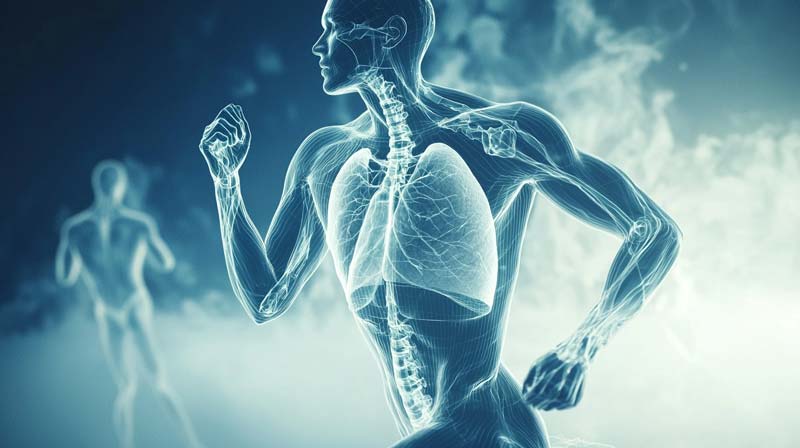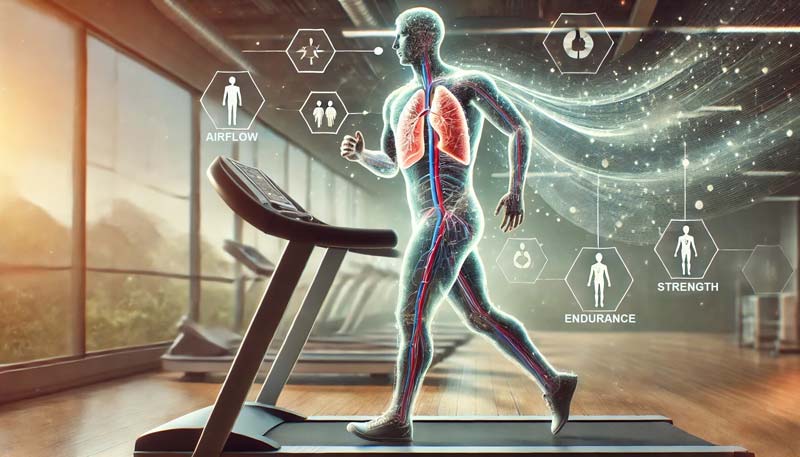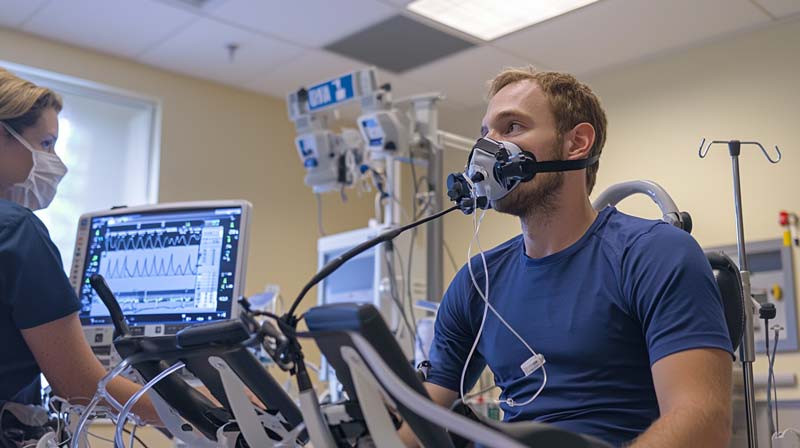By BeSund Editorial Team 11/07/2023 Modified Date: 22/10/2024
Respiratory Health
Dive into the impact of exercise on respiratory health
Respiratory Health and Exercise Benefits

Understanding Respiratory Health and Exercise
Respiratory health and exercise share a complex physiological relationship that significantly influences the prevention and management of chronic respiratory conditions. Within the global healthcare scene, chronic respiratory diseases affect hundreds of millions of individuals, presenting substantial challenges for both medical professionals and patients.
The physiological mechanisms underlying this relationship are multi-layered. During physical activity, the respiratory system undergoes significant adaptations, particularly in the diaphragm’s workload, which can increase up to 13-fold compared to quiet breathing. These adaptations enhance ventilatory efficiency and improve gas exchange capabilities.
Scientific evidence highlights the transformative impact of regular physical activity on respiratory function. Exercise produces vital physiological responses, including enhanced immune response, improved inflammatory control, and accelerated interaction between vagal and sympathetic nerves. Furthermore, these adaptations contribute to better respiratory muscle strength and enhanced pleural elasticity.
Types of Respiratory Disease
Chronic respiratory diseases encompass various conditions affecting respiratory health and exercise capacity through multiple mechanisms. The World Health Organization identifies several significant categories that significantly impact global health. Chronic Obstructive Pulmonary Disease (COPD), the third leading cause of death worldwide, claimed 3.23 million lives in 2019, with nearly 90% of deaths under age 70 occurring in low- and middle-income countries.
Asthma represents another prevalent respiratory condition, affecting an estimated 262 million people globally. This chronic lung disease causes inflammation and muscle tightening around the airways, leading to breathing difficulties that vary in severity. Additionally, occupational lung diseases emerge from workplace exposure to harmful dusts, chemicals, and fumes.
Cystic fibrosis presents unique challenges as an inherited disorder affecting respiratory function. The condition causes thick mucus accumulation in respiratory airways, reducing airflow and making it difficult to get air into the lungs. Despite aggressive treatment programs, individuals with cystic fibrosis require daily therapy to assist in mucus removal.
Idiopathic pulmonary fibrosis presents distinct challenges within the spectrum of respiratory conditions. This progressive disease leads to irreversible scarring of lung tissue, significantly impacting gas exchange and ventilatory capacity. The condition primarily affects older adults, causing worsening dyspnea and decreased lung function.
The Global Impact of Respiratory Disease on Health and Mortality
The World Health Organization (WHO) mortality database offers crucial insights into the global impact of respiratory diseases. The data selected from the WHO mortality database for this analysis focuses on Noncommunicable diseases. This category collects data for Chronic Obstructive Pulmonary Disease (COPD), asthma, and other respiratory diseases. These long-term conditions are manageable through lifestyle interventions, including exercise.
The WHO database also offers data on Communicable diseases, such as respiratory infections (e.g., COVID-19, pneumonia, upper respiratory infections). These were not selected as they are typically acute, and exercise is often not feasible during illness. Our focus remains on chronic diseases that benefit from sustained wellness strategies.
The interactive visualisation above reveals striking patterns in global respiratory health and exercise impacts across seven decades. The data shows respiratory diseases have become increasingly prominent as a cause of death globally.
In 1950, respiratory diseases accounted for 2.1% of total deaths, with 162,252 cases from 7.6 million deaths. This proportion grew significantly over the following decades. By 2020, respiratory diseases represented 5.2% of all deaths, reaching 1,643,614 instances.
Gender differences in respiratory disease mortality show an evolving pattern. In 1950, men accounted for 62.6% of respiratory deaths. This gender gap has narrowed over time, with male deaths representing 54.7% by 2020.
The data reveals notable spikes in specific periods. A sharp increase occurred between 1967 and 1968, with respiratory deaths jumping from 504,762 to 579,460. The peak came in 2017, with 2.1 million respiratory deaths compared to 39.2 million total deaths.
It’s important to note that data for 2021 and 2022 show a significant decline in recorded deaths. This reflects incomplete reporting, a limitation of the WHO database. The WHO continues to update these figures as new data becomes available. Therefore, the apparent drop in recent years doesn’t necessarily reflect actual mortality rates.
Understanding Respiratory System and Exercise Response
The impact of respiratory health and exercise manifests through complex physiological adaptations. The diaphragm’s role transforms significantly during physical activity, with pressure increasing twice and the shortening velocity changing to 6.5fold. These changes optimise ventilation and gas exchange efficiency, critical for exercise performance.
The respiratory system faces considerable challenges maintaining adequate gas exchange during physical activity. The process involves increased ventilatory demands, mechanical vibration, and alterations in pulmonary mechanics. Moreover, these adaptations help improve overall respiratory function through enhanced blood circulation and cardiovascular responses.
Scientific research demonstrates that regular exercise influences respiratory muscle function through multiple pathways. The training improves immediate responses, respiratory muscle strength, pleural elasticity, and pulmonary compliance within lung tissue.
Respiratory Health and Exercise: Benefits and Mechanisms
The relationship between respiratory health and exercise encompasses multiple beneficial mechanisms. Physical activity enhances the body’s immune response while simultaneously controlling inflammatory processes. These adaptations contribute significantly to improved respiratory function and symptom management.
Exercise training produces substantial improvements in ventilatory efficiency through various physiological pathways. Combined exercise approaches demonstrate particular effectiveness, increasing ventilation levels and air exchange frequency beyond what single-type training achieves. Furthermore, these adaptations persist, contributing to long-term respiratory health improvements.
Regular physical activity influences respiratory function through enhanced cardiopulmonary endurance. This improvement occurs through the expansion of airways and optimisation of lung capacity. Additionally, exercise helps strengthen respiratory muscles, leading to more efficient breathing patterns and reduced perception of breathlessness.
The Impact of Respiratory Health on Physical Performance
Physical capability relies heavily on efficient oxygen delivery and utilisation throughout the body. When respiratory function becomes compromised, individuals experience significant declines in exercise capacity and overall physical abilities.
Studies demonstrate that respiratory conditions create complex physiological challenges during physical exertion. These include impaired gas exchange, ventilatory limitations, and inadequate oxygen delivery to working muscles.
Research shows that respiratory health and exercise adaptations vary significantly across different conditions. While some individuals maintain relatively good exercise tolerance despite airflow limitations, others experience substantial restrictions in their physical capabilities.
Exercise Capacity and Cardiorespiratory Function
Maximum Oxygen Consumption
Poor respiratory health significantly impacts VO2 max, with research showing marked reductions in peak oxygen uptake. Studies indicate an annual decline of approximately 2 mL/min per kg bodyweight in affected individuals.
Cardiorespiratory Response
- Altered breathing mechanics during exertion
- Compromised oxygen delivery to tissues
- Modified heart rate patterns
- Increased ventilatory demands
Exercise tolerance becomes particularly challenging as respiratory health and exercise capacity decline, affecting high-intensity activities and everyday tasks.
Physiological Limitations During Activity
Ventilatory Constraints
Research reveals multiple mechanisms affecting physical performance:
Gas Exchange:
- Impaired oxygen uptake
- Reduced arterial oxygen content
- Increased work on breathing
- Enhanced respiratory muscle demands
Dynamic Hyperinflation
Studies show that many individuals experience increased end-expiratory lung volume during activity, significantly limiting exercise capacity.
Impact on Performance and Daily Function
Activity Limitations
The effects of respiratory conditions manifest across various domains:
Exercise Performance:
- Reduced endurance capacity
- Decreased work output
- Limited high-intensity abilities
- Compromised recovery rates
Respiratory health and exercise become particularly challenging during everyday activities, with research showing that even mild exertion can trigger significant symptoms. Studies indicate that maintaining regular physical activity helps slow the decline in lung function over time.
Clinical measures like the six-minute walk test effectively assess these limitations, providing valuable insights into functional capacity and disease progression. This knowledge helps guide appropriate interventions and activity modifications for affected individuals.

Exercise as a Management Tool for Respiratory Health
Physical activity is a powerful intervention for individuals with respiratory conditions, substantially improving symptoms and overall function.
Combined exercise approaches demonstrate particular effectiveness, increasing ventilation levels and air exchange frequency beyond what single-type training achieves.
The physiological adaptations from regular exercise enhance the body’s immune response while simultaneously controlling inflammatory processes. Understanding respiratory health and exercise adaptations reveals improved respiratory muscle strength, enhanced pleural elasticity, and better pulmonary compliance within lung tissue.
Aerobic training yields significant physiological benefits, particularly in reducing minute ventilation and heart rate at given workloads. In postmenopausal women with respiratory conditions, consistent physical activity correlates with decreased risk of exacerbations and improved symptom control.
Substantial evidence supports the role of resistance training in addressing respiratory limitations. This exercise strengthens respiratory and peripheral muscles, enhancing breathing patterns and reducing perceptions of breathlessness.
Additionally, resistance training improves thoracic mobility, directly supporting better lung function.
High-intensity interval training demonstrates particular promise in respiratory management, with studies highlighting the connection between respiratory health and exercise intensities. This approach allows individuals to achieve greater physiological adaptations while working within their ventilatory limitations. The intermittent nature of the exercise enables proper recovery periods, facilitating a longer duration of physical activity.
Balance and coordination exercises contribute significantly to respiratory management by improving posture and chest wall mechanics. These activities enhance breathing efficiency and help maintain proper alignment of respiratory muscles. When combined with breathing techniques, they offer comprehensive benefits for respiratory function.
Water-based exercises present unique advantages for respiratory management. The hydrostatic pressure on the chest wall provides natural resistance for respiratory muscles, while the environment supports more effortless movement. This combination allows for effective exercise with reduced symptoms of breathlessness.
Recommended Exercises for Individuals with Respiratory Health and Exercise Needs
Physical activity programmes offer significant benefits when properly structured and implemented. Scientific evidence supports specific exercise modalities that enhance respiratory function while maintaining safety and effectiveness.
Studies demonstrate that respiratory health and exercise programmes yield remarkable improvements in functional outcomes through systematic progression. Multiple training approaches contribute to enhanced respiratory capacity.
Core Exercise Components and Respiratory Health and Exercise Applications
Aerobic Exercise Foundation
Regular aerobic activities form the cornerstone of respiratory conditioning. Walking, cycling, and swimming provide fundamental benefits:
- Walking programmes build endurance gradually, starting with short intervals and progressing based on individual tolerance. Indoor walking offers controlled environments ideal for monitoring symptoms and responses.
- Stationary cycling allows precise workload adjustments while minimising the impact on joints. This activity proves particularly beneficial for those with balance concerns or mobility limitations.
- Water-based exercises provide natural resistance while supporting body weight, creating an ideal environment for strength and endurance.
Breathing Enhancement Techniques
Specialised breathing exercises complement physical activities, enhancing respiratory health and exercise adaptations:
- Diaphragmatic breathing strengthens primary respiratory muscles
- Pursed-lip breathing helps control breathing rate during exertion
- Segmental breathing improves specific areas of lung expansion
- Electronic breathing devices support precise training progression
Strength Development Protocol
Resistance training targets key muscle groups:
- Upper body exercises enhance accessory breathing muscles
- Lower body training improves overall functional capacity
- Core strengthening supports proper breathing mechanics
These exercises incorporate appropriate rest periods and careful progression to maintain optimal training effects while preventing overexertion.
FITT Recommendations for Respiratory Conditions
The FITT principle provides a structured framework for exercise prescription, considering frequency, intensity, time, and type of activities. Current respiratory health and exercise research validates specific parameters for optimal adaptation.
Frequency Guidelines
Begin with 3-5 sessions weekly, allowing adequate recovery between workouts. Progressive increases depend on individual tolerance and response to training.
Intensity Parameters
- Light to moderate: 40-60% of maximum capacity
- Rate of perceived exertion: 3-4 on the modified Borg scale
- Heart rate monitoring when appropriate
- Oxygen saturation maintained above 88%
Time Considerations
Start with 10-15 minute sessions, gradually increasing to 20-40 minutes as tolerated. Include proper warm-up and cool-down periods.
Type Selection
Choose activities based on:
- Individual preferences and capabilities
- Available equipment and resources
- Environmental conditions
- Disease severity and limitations
Activity Modifications
Adapt exercises according to:
- Current symptoms
- Energy levels
- Environmental factors
- Available support systems
Recent research supports additional training strategies:
- Combined strength-endurance programmes show superior outcomes
- High-intensity interval training enables more extended training periods
- Electronic monitoring devices enable precise progression tracking
- Periodised training cycles support systematic advancement

Safety Measures and Precautions for Exercising with Respiratory Conditions
Safety protocols form the foundation of adequate physical activity programmes for respiratory patients. Systematic monitoring and precise progression strategies significantly enhance exercise outcomes while minimising potential risks.
The relationship between respiratory health and exercise necessitates careful consideration of multiple physiological markers. Transcutaneous oxygen saturation levels require consistent monitoring, particularly during higher-intensity activities, with supplemental oxygen provided when saturation drops below 88%.
Essential Monitoring Parameters:
- Blood pressure and heart rate tracking
- Oxygen saturation maintenance above 88%
- Modified Borg scale ratings (target 4-6)
- Electrocardiogram changes during activity
- Clinical symptom observation
Progressive intensity adaptation is crucial in maintaining respiratory health and exercise safety. Training loads should increase systematically:
Initial Phase:
- Start at 40-60% of maximum capacity
- Monitor perceived exertion (3-4 on the Borg scale)
- Allow adequate recovery between sessions
- Adjust based on individual responses
Advanced Progression:
- Increase to 60-85% of maximum capacity
- Maintain perceived exertion below 7
- Implement interval training when appropriate
- Monitor recovery capacity between efforts
Specific safety considerations vary based on the severity of the respiratory condition.
Mild to Moderate Conditions:
- Regular spirometry assessments
- Gradual workload progression
- Environmental factor management
- Symptom tracking during activity
Severe Conditions:
- Continuous oxygen monitoring
- Modified exercise protocols
- Enhanced recovery periods
- Close supervision requirements
Medical Consultation Timing:
- Before initiating new exercise programmes
- When symptoms change significantly
- If experiencing unusual fatigue
- During medication adjustments
Additional safety measures include optimising bronchodilator therapy before exercise sessions and ensuring proper ventilation in training environments. Individual exercise prescriptions require regular reassessment and modification based on disease progression and treatment responses.

Living with Respiratory Health and Exercise: Fitness and Lifestyle Tips
Daily lifestyle modifications create the foundation for successful respiratory health management. Beyond structured exercise sessions, incorporating targeted activities into everyday routines significantly enhances long-term outcomes.
Studies demonstrate that consistent daily practices substantially improve respiratory function and exercise tolerance with proper nutritional support.
Integrating respiratory health and exercise into daily life requires careful attention to nutrition. Mediterranean-style eating patterns, rich in fruits, vegetables, and whole grains, help reduce inflammation and support exercise recovery. Research validates the importance of maintaining adequate protein intake for muscle preservation, particularly in individuals with chronic respiratory conditions.
Environmental considerations play a crucial role in exercise success. Indoor air quality, temperature control, and proper ventilation significantly impact exercise tolerance and respiratory comfort. Seasonal modifications prove essential, with outdoor activities requiring careful planning around pollution levels, pollen counts, and weather conditions.
Essential Daily Practices for Optimal Management:
- Regular inspiratory muscle training sessions
- Pursed lip breathing during activities
- Strategic medication timing with exercise
- Consistent hydration maintenance
- Energy conservation techniques
Digital health technologies have revolutionised long-term respiratory management. Modern applications enable remote monitoring, virtual support communities, and flexible scheduling approaches. These tools help maintain respiratory health and exercise consistency while providing valuable data for healthcare providers.
Regular assessment and adaptation remain crucial for sustained progress. Working closely with healthcare professionals ensures appropriate progression and modification of activities. This collaborative approach and community support programmes enhance long-term adherence to lifestyle modifications.
Incorporating stress management techniques further supports respiratory health. Mindfulness practices, breathing exercises, and relaxation methods complement physical activities. Research shows that managing psychological well-being significantly impacts respiratory symptoms and exercise tolerance.
Nutrition plays a fundamental role in supporting respiratory function and exercise capacity. Current evidence supports specific dietary strategies:
- Anti-inflammatory food choices
- Balanced macronutrient distribution
- Appropriate meal timing around exercise
- Targeted supplementation when indicated
Sources
- Aliverti A, Cala SJ, Duranti R, et al. Human respiratory muscle actions and control during exercise. J Appl Physiol. 1997;83(4):1256-1269.
- Babb TG, Long KA, Rodarte JR. The relationship between maximal expiratory flow and increases of maximal exercise capacity with exercise training. Am J Respir Crit Care Med. 1997;156:116-121.
- Beauchamp MK, Nonoyama M, Goldstein RS, et al. Interval versus continuous training in individuals with chronic obstructive pulmonary disease — a systematic review. Thorax 2010; 65(2): 157-164.
- Casaburi R, Porszasz J, Burns MR, et al. Physiologic benefits of exercise training in rehabilitation of patients with severe chronic obstructive pulmonary disease. Am J Respir Crit Care Med. 1997;155:1541-1551.
- Cerny FJ. Relative effects of bronchial drainage and exercise for in-hospital care of patients with cystic fibrosis. Physical Therapy. 1989;69(8):633-639.
- Chen JJ, Cooper DM, Haddad F, et al. Tele-exercise is a promising tool for promoting exercise in children with cystic fibrosis. Frontiers in Public Health 2018; 6: 269.
- da Silva R, Leite Rocco PG, Stelmach R. Constant-load exercise versus high-intensity interval training on aerobic fitness in moderate-to-severe asthma: a randomised controlled trial. Journal of Allergy and Clinical Immunology Practice 2022; 10: 2596-604.
- Di Marco F, Sotgiu G, Santus P, et al. Long-acting bronchodilators improve exercise capacity in COPD patients: a systematic review and meta-analysis. Respiratory Research 2018; 19: 18.
- Dwyer TJ, Alison JA, McKeough ZJ, Daviskas E, Bye PT. Effects of exercise on respiratory flow and sputum properties in patients with cystic fibrosis. Chest. 2011;139(4):870-877.
- Emtner M, Wadell K. Effects of exercise training in patients with chronic obstructive pulmonary disease – a narrative review for FYSS. British Journal of Sports Medicine 2016; 50(6): 368-371.
- Freitag N, Doma K, Neunhaeuserer D, et al. Is structured exercise performed with supplemental oxygen a promising method of personalised medicine in the therapy of chronic diseases? Journal of Personalized Medicine 2020; 10: 135.
- Freitas PD, Passos NFP, Carvalho-Pinto RM. A behavior change intervention aimed at increasing physical activity improves clinical control in adults with asthma: a randomised controlled trial. Chest 2021; 159: 46-57.
- Global Initiative for Chronic Obstructive Lung Disease. Global Strategy For Prevention, Diagnosis and Management of COPD: 2024 Report.
- Garcia-Aymerich J, Varraso R, Antó J, Camargo CA Jr. Prospective study of physical activity and risk of asthma exacerbations in older women. American Journal of Respiratory and Critical Care Medicine 2009; 179: 999-1003.
- Gosselink R, De Vos J, van den Heuvel SP, et al. Impact of inspiratory muscle training in patients with COPD: what is the evidence? Eur Respir J. 2011;37:416-425.
- Hansen ESH, Pitzner-Fabricius A, Toennesen LL, Rasmusen HK, Hostrup M, Hellsten Y, Backer V, Henriksen M. Effect of aerobic exercise training on asthma in adults: a systematic review and meta-analysis. European Respiratory Journal 2020; 56(1): 2000146.
- Holland AE, Cox NS, Houchen-Wolloff L, et al. Defining modern pulmonary rehabilitation. An Official American Thoracic Society Workshop Report. Annals of the American Thoracic Society 2021; 18: e12-e29.
- Kortianou EA, Nasis IG, Spetsioti ST, Daskalakis AM, Vogiatzis I. Effectiveness of Interval Exercise Training in Patients with COPD. Cardiopulmonary Physical Therapy Journal 2010; 21(3): 12-19.
- Langer D, Charususin N, Jácome C, et al. Efficacy of a novel method for inspiratory muscle training in people with chronic obstructive pulmonary disease. Physical Therapy 2015; 95: 1264-1273.
- Loponen J, et al. Daily physical activity and lung function decline in adult-onset asthma: a 12-year follow-up study. European Clinical Respiratory Journal 2018; 24: 1533753.
- Maltais F, Decramer M, Casaburi R, et al. An official American Thoracic Society/European Respiratory Society statement: update on limb muscle dysfunction in chronic obstructive pulmonary disease. American Journal of Respiratory and Critical Care Medicine 2014; 189: e15–e62.
- Morris NR, Walsh J, Adams L, et al. Exercise training in COPD: what is it about intensity? 2016;21:1185-1192.
- Nici L, Donner C, Wouters E, et al. American Thoracic Society/European Respiratory Society statement on pulmonary rehabilitation. American Journal of Respiratory and Critical Care Medicine 2006; 173(12): 1390-1413.
- Nonoyama ML, Brooks D, Lacasse Y, Guyatt GH, Goldstein RS. Oxygen therapy during exercise training in chronic obstructive pulmonary disease. Cochrane Database of Systematic Reviews 2007; 18(2): CD005372.
- O’Donnell DE, Banzett RB, Carrieri-Kohlman V, et al. Pathophysiology of dyspnea in chronic obstructive pulmonary disease: a roundtable. Proc Am Thorac Soc. 2007;4:145-168.
- O’Donnell DE, Hamilton AL, Webb KA. Sensory-mechanical relationships during high-intensity, constant-work-rate exercise in COPD. Journal of Applied Physiology 2006; 101: 1025–1035.
- O’Donnel DE, Revill SM, Webb KA. Dynamic hyperinflation and exercise intolerance in chronic obstructive pulmonary disease. American Journal of Respiratory and Critical Care Medicine 2001; 164(5): 770-777.
- Pianosi P, LeBlanc J, Almudevar A. Peak oxygen uptake and mortality in children with cystic fibrosis. Thorax 2005; 60(1): 50-54.
- Price OJ, Simpson AJ. Exercise and asthma – trigger or treatment? Respiratory Medicine 2023.
- Puetz TW. Physical activity and feelings of energy and fatigue. Sports Medicine 2006; 36: 767-780.
- Reznik M, Islamovic F, Choi J, Leu CS, Rowlands AV. Factors associated with in-school physical activity among urban children with asthma. Journal of Asthma 2018; 55(5): 492-501.
- Rochester CL, Fairburn C, Crouch RH. Pulmonary rehabilitation for respiratory disorders other than chronic obstructive pulmonary disease. Clinics in Chest Medicine 2014; 35(2): 369-389.
- Sanz-Santiago V, Diez-Vega I, Santana-Sosa E. Effect of a combined exercise program on physical fitness, lung function, and quality of life in patients with controlled asthma and exercise symptoms: a randomised controlled trial. Pediatric Pulmonology 2020; 55: 1608-1616.
- Sawyer A, Cavalheri V, Jenkins S, et al. High-intensity interval training is effective at increasing exercise endurance capacity and is well tolerated by adults with cystic fibrosis. Journal of Clinical Medicine 2020; 9(10): 3098.
- Shen L, Zhang Y, Su Y, et al. New pulmonary rehabilitation exercise for pulmonary fibrosis to improve the pulmonary function and quality of life of patients with idiopathic pulmonary fibrosis: a randomised control trial. Annals of Palliative Medicine 2021; 10(7): 7289-7297.
- Silva L, Maricoto T, Costa P, et al. A meta-analysis on the structure of pulmonary rehabilitation maintenance programmes on COPD patients’ functional capacity. NPJ Primary Care Respiratory Medicine 2022; 32: 38.
- Spruit MA, Singh SJ, Garvey C, et al. An Official American Thoracic Society/European Respiratory Society Statement: Key Concepts and Advances in Pulmonary Rehabilitation. American Journal of Respiratory and Critical Care Medicine 2013; 188: e13-64.
- Strasser B, Siebert U, Schobersberger W. Effects of resistance training on respiratory function in patients with chronic obstructive pulmonary disease: a systematic review and meta-analysis. Sleep and Breathing 2013; 17(1): 217-226.
- Thannickal VJ, Toews GB, White ES, Lynch JP, Martinez FJ. Mechanisms of pulmonary fibrosis. Annu Rev Med. 2004;55:395-417.
- Toennesen LL, Meteran H, Hostrup M, et al. Effects of exercise and diet in nonobese asthma patients – a randomised controlled trial. Journal of Allergy and Clinical Immunology in Practice 2018; 6: 803-811.
- World Health Organization. Asthma – Key Facts.
- World Health Organization. Chronic Respiratory Diseases.
- World Health Organization. Physical Activity.
- World Health Organization. The WHO Mortality Database for Respiratory Disease.
- Xiong T, Bai X, Wei X, Wang L, Li F, Shi H, Shi Y. Exercise Rehabilitation and Chronic Respiratory Diseases: Effects, Mechanisms, and Therapeutic Benefits. Int J Chron Obstruct Pulmon Dis. 2023;18:1251-1266.


